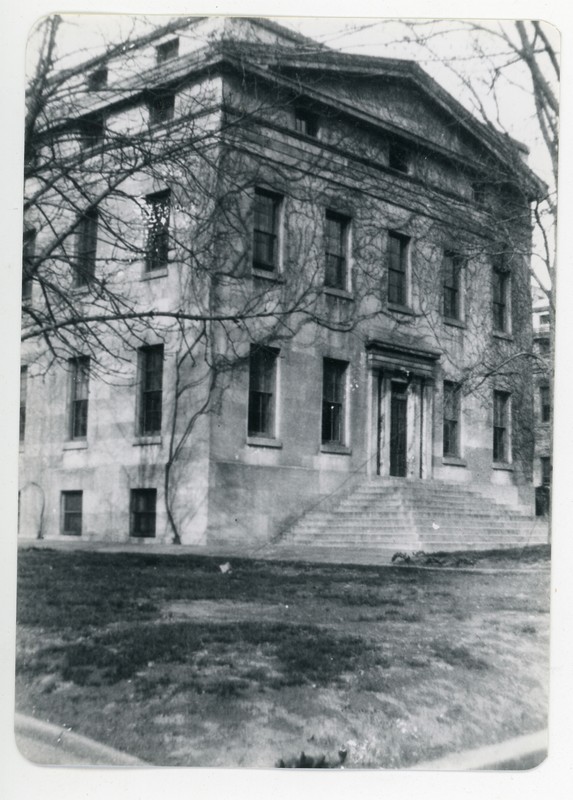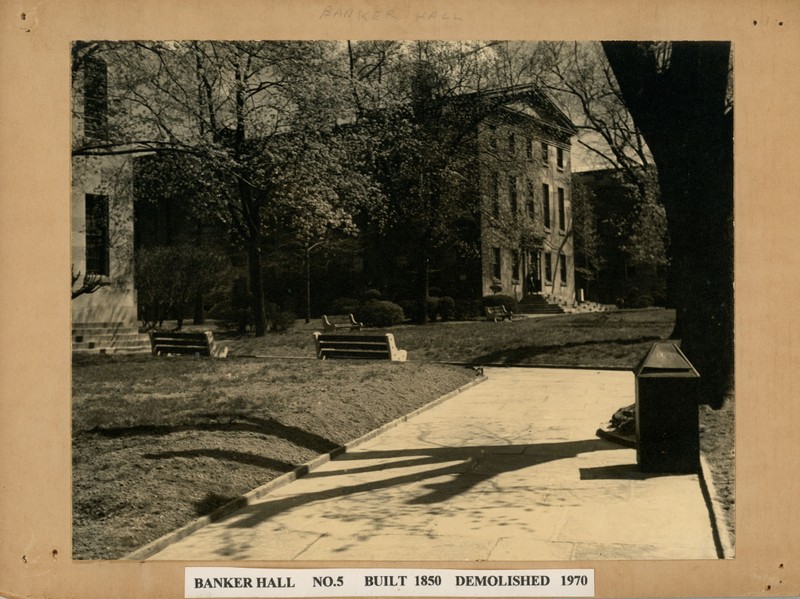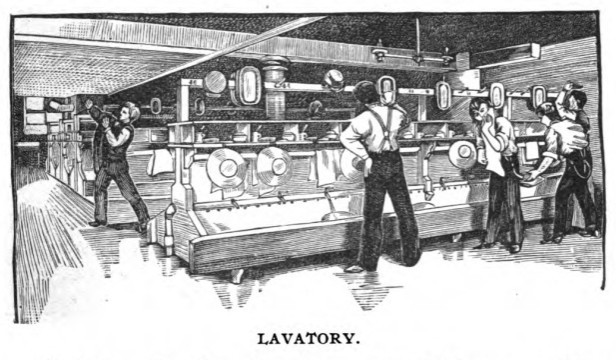Banker Hall (1850-1970)
Introduction
Text-to-speech Audio
Images
Photo of Banker Hall

Photo of Banker Hall in background.

1888 illustration of students washing up in a lavatory (wash basin room) of Banker Hall.

Backstory and Context
Text-to-speech Audio
Girard College discovered issues in its water system shortly after it opened in 1848. The next year, a new service building was proposed, which would supply the campus with a larger and more reliable water facility. Construction for Building #5, the first major campus building to be erected after the school’s opening, began in 1850 and was completed in 1851. Building #5 consisted of three floors and a basement and was built with the same type of stone used for the perimeter wall of Girard College. For several decades, Building #5 stored water pumped from an adjacent well and provided steam heating for all buildings on campus grounds. Four large water storage tanks and pumps were set up on the top floor in the back of the building and a boiler was located in the basement. Pipes in underground tunnels carried steam from Building #5 to all campus buildings. The building held other campus services and student facilities as well. The bakery was located in the basement, while the laundry was located on the first floor. Classrooms for foreign language, drawing, penmanship, and bookkeeping classes, as well as a chemistry laboratory, were located on the first and second floors. Between 1850-1863, administrators confined children who acted disobediently or disorderly in a disciplinary room on the top floor.
Growing student enrollment soon prompted Girard College to renovate Building #5‘s classrooms into dormitory accommodations in 1856. The dormitory would house up to 140 students at a time, most of whom were between ages 14-17. A gymnasium was built on the second floor in 1860. In 1877, Girard College was incorporated into the city’s water works system. In 1878, Building #5 underwent a major enlargement project that included interior renovations, exterior remodelling, and an expansion of living accommodations. Bathing pools, wash basin rooms, and a handicraft workshop were all installed in the basement for student use. Offices for the president, vice president, and steward were stationed on the first floor. A spacious fireproof stairway was built into the infrastructure. Building #5 was now heated by steam transferred through the underground tunnels from a campus boiler-house. The building’s front exterior was refurbished with plaster and marble to match the appearance of Buildings #1-#4. By the 1880s, the section rooms were located on the first floor, with student dorms, residential staff’s rooms, and linen rooms on the second and third floors. In 1916, the administrative offices were moved to the High School Building, while the section rooms were enlarged.
When all numbered buildings on campus officially received names in 1927, Building #5 was renamed Banker Hall, after one of the professions held by school founder Stephen Girard during his lifetime. The house system was introduced among the dormitory buildings of Girard College during the same year. Banker became one of the four high school dormitory houses, and competed against students from Bordeaux, Mariner, and Merchant Halls in intramural sports competitions. In 1945, the school made plans to demolish Banker Hall. The dormitory was originally designed as a service building, and would better serve students by being replaced with a modernized dormitory that could accommodate a greater number of students in smaller housing units. However, Girard College abandoned the idea of replacing the building as enrollment declined. In 1946, the dormitory placement system was changed so that Banker and Merchant Halls housed only students from the lower high school grades. The dormitory placement system was changed again five years later, assigning all 7th-9th grade students to Banker Hall. In 1949, alumni and high school students raised money to install television sets in the five upper houses, including Banker Hall.
In the fall of 1952, a handful of students caused the largest fire ever recorded in the school’s history. The Banker Hall fire may have been ignited by cigarettes, which students were prohibited from smoking whether on or off Girard College grounds. There were fortunately no casualties, and the $10,000 in property damage was covered by insurance. The roof had to be repaired, doors and air vents walled up, and much of the building had to be replastered, repainted, and reconditioned to prevent future fires. Five students were expelled for causing the fire.
Banker Hall was eventually demolished in 1970. Soon after, the existing Dining and Service Building was partially renovated into dormitory space and was renamed as the new Banker Hall in 1973. In 1977, the grounds of the former Banker Hall were landscaped, installed with sidewalks, and turned into a campus green space which continues to exist today.
Sources
Chronology of GIRARD COLLEGE, 1832-2016. June 2016. Compiled by Gil Bunker, Thomas J. DiFilippo, Walter C. Gold, and Cheesman A. Herrick for the Founder's Hall collections in Girard College.
DiFilippo, Thomas J. Stephen Girard, The Man, His College and Estate. Edition 2nd. 1999. Accessed August 24 2020. http://www.girardweb.com/girard/contents.htm.
Girard College, Ninth Annual Report of the Board of Directors of City Trusts - Report for the Year 1878. Philadelphia, PA. 1879.
Girard College. President's Reports and Catalogue of Pupils - Girard College, The City of Philadelphia, Trustee. Philadelphia, PA.
Herrick, Cheesman A. History of Girard College. Philadelphia, PA. Girard College, 1927.
Scattergood, David. Hand Book of Girard College. Illustrated. Philadelphia, PA. D. Scattergood, 1888.
Girard College Historical Collections.
Girard College Historical Collections.
Scattergood, David. Hand Book of Girard College. Illustrated, Page 19. Philadelphia: D. Scattergood, 1888.
